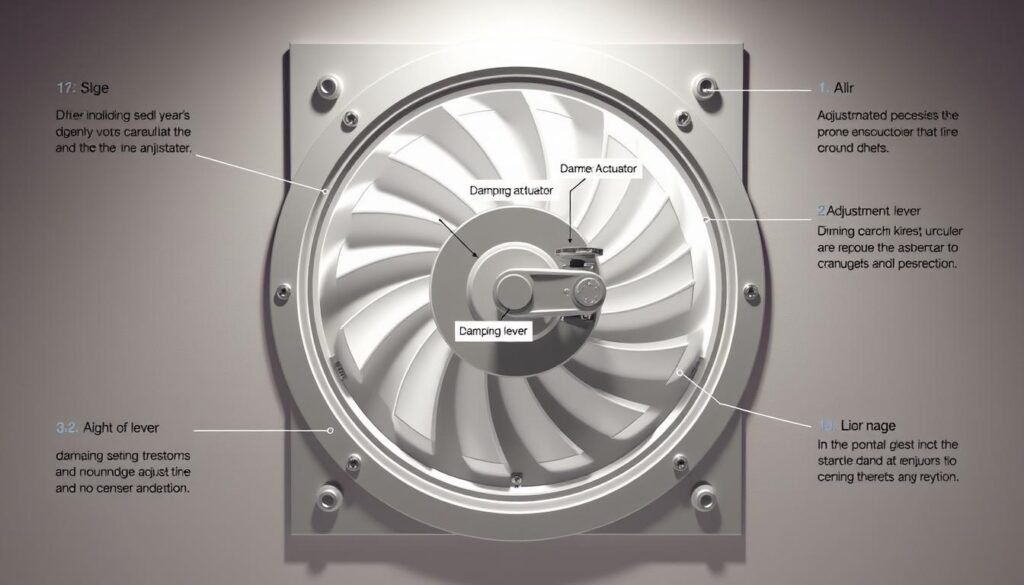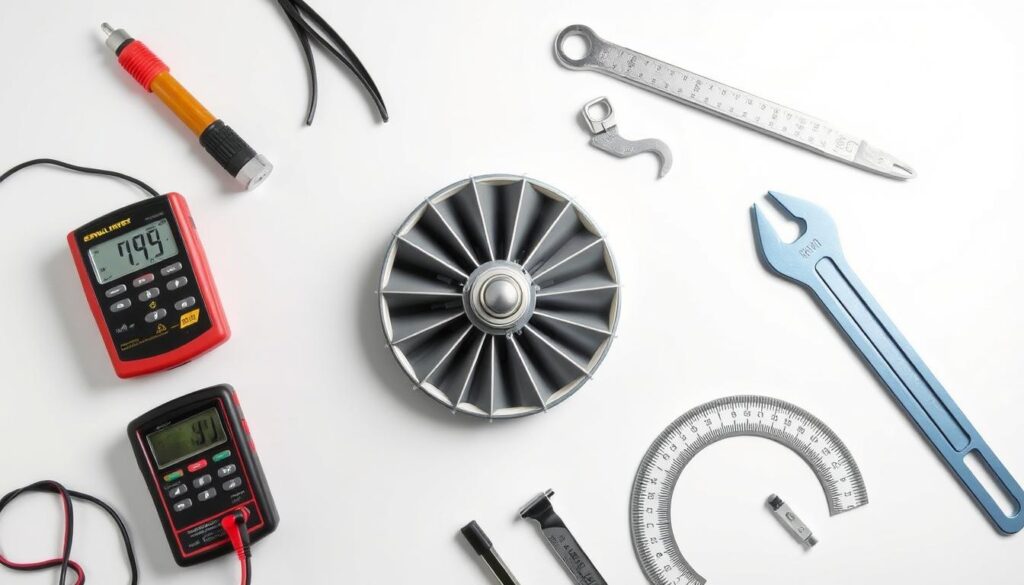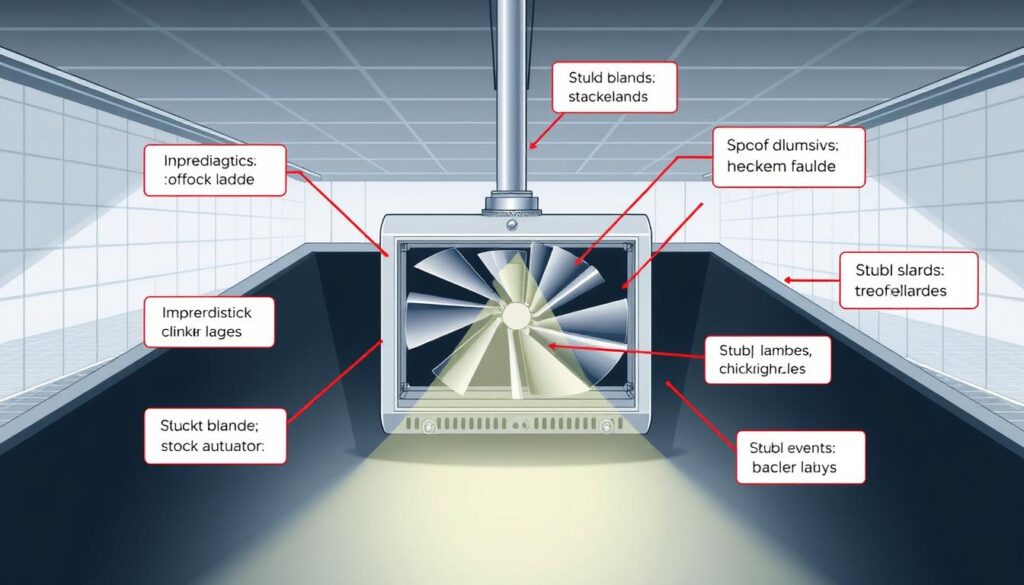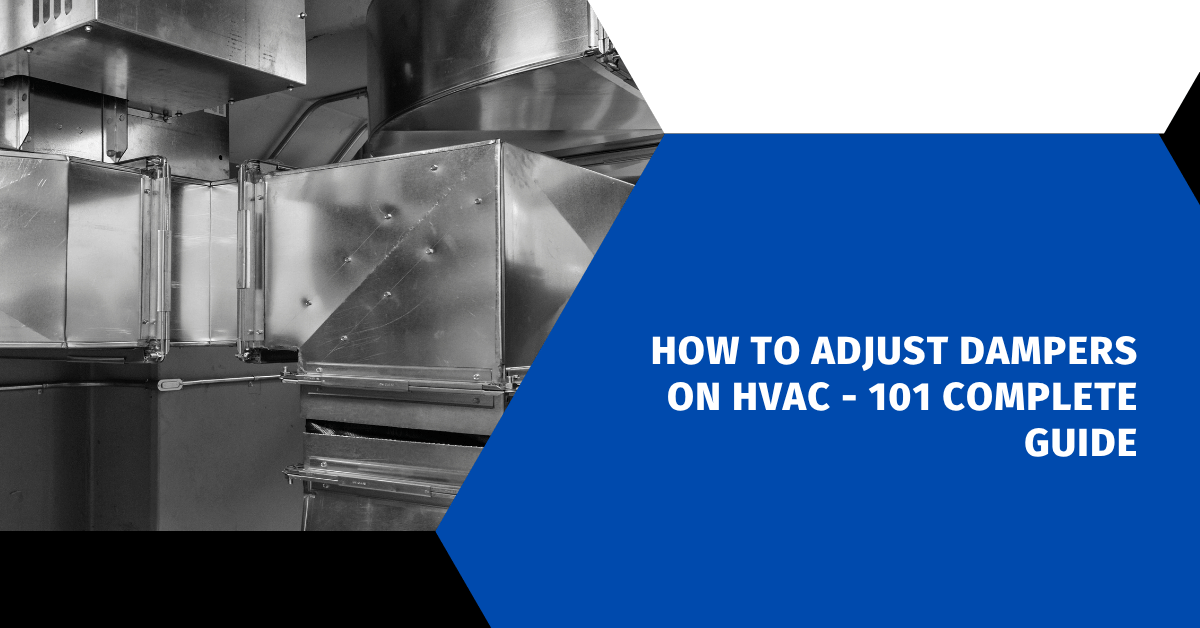Affiliate Disclosure
HVAC Guide Guys is a participant in the Amazon Services LLC Associates Program, an affiliate advertising program designed to provide a means for sites to earn advertising fees by advertising and linking to Amazon.
How to Adjust Dampers on HVAC? Are you tired of uneven temperatures and high energy bills in your home? What if you could make your HVAC system work better with a simple adjustment that most homeowners miss?

HVAC damper adjustment is a powerful technique. It can greatly improve your home’s comfort and energy use. These small parts control airflow through your ductwork. They let you direct heating and cooling exactly where you need it.
Learning how to adjust dampers on HVAC can make your home more comfortable and save energy. This guide will show you how to fix hot spots, cold rooms, and uneven temperatures. You’ll learn everything about HVAC damper adjustment.
Key Takeaways
- Dampers are essential for controlling airflow in your HVAC system
- Proper adjustment can improve home comfort and energy efficiency
- Most homeowners can perform basic damper adjustments
- Regular damper maintenance prevents potential HVAC issues
- Zoning your home with dampers can lead to significant energy savings
Table of Contents
Understanding HVAC Dampers and Their Role
Your home’s HVAC system is more complex than you might realize. At the heart of efficient air distribution are HVAC dampers – small but powerful components. They play a crucial role in hvac air flow regulation. These metal plates act like traffic controllers within your ductwork, directing heated or cooled air exactly where you need it.
What Are HVAC Dampers?
Dampers are adjustable plates installed inside air ducts. They open, close, or partially restrict airflow to different areas of your home. Think of them as precise valves that help manage temperature and comfort in individual rooms or zones. Their primary function supports hvac duct balancing by ensuring optimal air distribution.
How Dampers Control Airflow
- Regulate air volume to specific rooms
- Prevent overheating or overcooling in certain areas
- Create customized temperature zones
- Improve overall HVAC system efficiency
Benefits of Proper Damper Adjustment
Correctly adjusted dampers offer significant advantages for homeowners:
- Enhanced Energy Efficiency: Reduce wasted energy by directing air precisely
- Improved Comfort: Eliminate temperature variations between rooms
- Cost Savings: Optimize your HVAC system’s performance
Proper damper management is key to maintaining a comfortable and energy-efficient home environment.
Explore Our HVAC Shop
Looking for top-rated HVAC tools, parts, and accessories? Visit our shop and find the perfect solution for your needs.
Visit the ShopTypes of HVAC Dampers for Home Systems
It’s important to know about the different types of dampers for your HVAC system. Each type has its own role in controlling air flow in your home’s heating and cooling system.
Today’s HVAC systems use special dampers to manage air flow well. These parts help keep your home at a comfortable temperature and save energy.
Butterfly Flat Dish Dampers
Butterfly flat dish dampers have a simple design. They have a disk that turns to control air flow in round ducts. Their benefits include:
- Lightweight construction
- Easy installation
- Smooth air regulation
- Minimal pressure drop
Blade Dampers
Blade dampers offer better control over air flow. They have metal blades that move to adjust air flow. This makes them great for managing air in your HVAC system.
Louver and Inlet Vane Dampers
Louver and inlet vane dampers are very flexible. They’re good for:
- Industrial ventilation systems
- Commercial HVAC applications
- Precise airflow direction
- Energy efficiency improvements
Choosing the right damper depends on your HVAC system’s needs and your air flow goals.
Locating Dampers in Your HVAC System
Knowing where dampers are is key for good hvac ventilation control. Dampers in your HVAC system help manage air flow in your home. They are often hidden in the ductwork, so you might need to search a bit to find them.
Dampers are placed in key spots to improve air distribution. You’ll usually find them in these areas:
- Main trunk lines near furnace or AC unit
- Junction points between major duct sections
- Rectangular or round ductwork connections
To find your system’s dampers, look for these signs:
- Small metal levers or wing nuts on duct exteriors
- Labeled markers showing open/closed or winter/summer settings
- Metal plates inside ductwork that can turn or adjust
| Damper Location | Typical Characteristics |
|---|---|
| Main Trunk Line | Two dampers positioned 90 degrees apart |
| Zone Systems | Multiple dampers controlling different home areas |
| Near HVAC Unit | Closest access points for manual adjustment |
Experts say tracing your ductwork is the best way to find all dampers. If you’re not sure where to look, a local heating and cooling pro can help. They’ll give you the right advice for your system.
Explore Our HVAC Shop
Looking for top-rated HVAC tools, parts, and accessories? Visit our shop and find the perfect solution for your needs.
Visit the ShopHow to Adjust Dampers on HVAC
Adjusting dampers in your HVAC system can make your home more comfortable and energy-efficient. It’s important to know how to adjust them. You’ll need some basic skills and a good understanding of your home’s ventilation system.

Essential Tools for HVAC Damper Adjustment
Before you start adjusting your HVAC dampers, make sure you have these tools:
- Flathead screwdriver
- Flashlight
- Ladder (if accessing attic or crawl spaces)
- Work gloves
Step-by-Step Adjustment Process
Here’s how to adjust your HVAC dampers:
- Find the damper control lever inside the ductwork
- Decide if you want to open or close the damper
- Slowly turn the lever parallel or perpendicular to the duct
- Make small, incremental adjustments
Testing Airflow After Adjustments
After adjusting the dampers, check the changes by looking at room temperatures and airflow. Walk around your home and feel the air from different vents. A good adjustment will make temperatures more even across rooms.
Pro Tip: Always make minor adjustments and wait 15-20 minutes to see how it affects your home’s temperature.
Seasonal Damper Adjustment Guidelines
Learning about seasonal HVAC temperature zoning can make your home more comfortable and energy-efficient. As the seasons change, your HVAC system needs adjustments to keep your home at the right temperature.
In summer, cooling your home is a big challenge. Hot air rises, making different floors have different temperatures. Your HVAC dampers help manage these temperature differences.
- Open upper floor dampers wider to increase cool air circulation
- Partially close lower floor dampers to redirect cooling
- Adjust damper settings to compensate for heat stratification
Winter requires a different approach to temperature zoning. Lower floors are often cooler, needing more heat. Adjust your dampers to warm up ground-level spaces more.
| Season | Upper Floor Dampers | Lower Floor Dampers |
|---|---|---|
| Summer | More Open | Partially Closed |
| Winter | Partially Closed | More Open |
Make a seasonal adjustment schedule to save energy. Check and adjust your damper settings often. This will help your home stay comfortable and energy-efficient.
Common Problems with HVAC Dampers
Keeping your HVAC system tuned is crucial. It helps avoid damper issues that can mess with your home’s comfort and energy use. Knowing the signs of damper problems helps keep your HVAC running smoothly and prevents bigger issues.

Signs of Malfunctioning Dampers
Spotting damper problems early can save you money. Look out for these key signs:
- Uneven temperature zones in different rooms
- Unusual rattling or clicking sounds from ductwork
- Sudden increases in energy bills
- Reduced airflow from specific vents
Troubleshooting Tips
Try these steps before you call a pro for HVAC tuning:
- Visually inspect damper positions
- Check for physical obstructions in ductwork
- Test manual damper movement
- Listen for unusual mechanical resistance
When to Call a Professional
Some damper issues need a pro’s touch. Call a professional if you see these signs:
| Problem | Professional Action Required |
|---|---|
| Completely stuck dampers | Mechanical repair or replacement |
| Persistent airflow imbalance | Comprehensive system diagnostic |
| Electrical control failures | Wiring and control system inspection |
Professional HVAC techs can do detailed diagnostics. They ensure your system works at its best.
Explore Our HVAC Shop
Looking for top-rated HVAC tools, parts, and accessories? Visit our shop and find the perfect solution for your needs.
Visit the ShopOptimizing Energy Efficiency Through Damper Control
Mastering hvac energy efficiency begins with understanding dampers’ role. Dampers are key to controlling hvac air distribution. They help manage airflow in your home.
Using dampers wisely can cut your energy costs. It lets you set up specific heating and cooling zones. This way, you direct airflow where it’s needed, saving energy and boosting your HVAC’s performance.
- Reduce energy consumption by up to 20% through precise airflow management
- Create custom temperature zones in different rooms
- Minimize unnecessary heating and cooling of unused spaces
Pro tip: Combine damper adjustments with programmable thermostats for maximum energy savings.
“Smart damper control is like having a precision instrument for your home’s comfort and efficiency.” – HVAC Engineering Expert
Optimizing hvac air distribution saves money and makes your home more comfortable. Regular damper checks and smart adjustments make your HVAC system work better.
Proper damper control offers many benefits:
- Lower energy bills
- More consistent room temperatures
- Reduced wear and tear on HVAC equipment
- Enhanced overall system performance
By using these damper control strategies, you’ll make your HVAC system efficient and responsive. It will adapt to your needs.
Manual vs. Automatic Damper Systems
Choosing the right damper system for your HVAC is key to your home’s comfort. Knowing the difference between manual and automatic systems helps you pick the best one for you.
Pros and Cons of Each Type
When thinking about hvac temperature zoning, you have two main options:
- Manual Dampers
- Lower initial cost
- Simple mechanical design
- Requires physical adjustment
- Automatic Dampers
- Precise temperature control
- Smart home integration
- Higher upfront investment
Installation Considerations
Your home’s HVAC setup is important when choosing a damper system. Older systems might need more work for automatic dampers. But, newer homes can easily fit advanced zoning tech.
Cost Comparison
| Damper Type | Initial Cost | Long-Term Savings |
|---|---|---|
| Manual Dampers | $50-$200 | Limited |
| Automatic Dampers | $300-$1,000 | Significant |
Your choice depends on your budget, comfort needs, and energy savings goals.
Maintaining Your HVAC Damper System
It’s vital to keep your HVAC damper system in great shape. This ensures your home stays comfortable all year. Regular upkeep is key for both performance and energy savings.
Looking after your dampers involves a few essential steps:
- Do a visual check every three months
- Wash damper parts with care
- Look for wear or damage signs
- Oil moving parts when needed
Dust and dirt can really hurt your system’s airflow. Regular cleaning stops these issues from building up and slowing down your system. Use a soft brush or a vacuum with a brush to clean dust off gently.
Getting a pro to check your system yearly is a good idea. They can:
- Do a full system check
- Spot problems early
- Make sure dampers are set right
- Get electronic parts clean and working right
Seasonal changes can mess with your damper system. Before winter and summer, check and tweak your dampers. This keeps airflow and energy use at their best.
Pro tip: Keep a maintenance log to track your HVAC system’s performance and identify patterns over time.
Explore Our HVAC Shop
Looking for top-rated HVAC tools, parts, and accessories? Visit our shop and find the perfect solution for your needs.
Visit the ShopUnderstanding Zoning and Temperature Control
HVAC temperature zoning is a game-changer for home comfort. Your home doesn’t have to be one temperature anymore. Now, you can make each room its own comfort zone with advanced air distribution.
Zoning lets you set different temperatures in different parts of your home. So, your bedroom can be cool while your living room is warm. Or, your home office can be cooler than your kitchen.
- Customize temperature for individual rooms
- Reduce energy waste
- Improve overall home comfort
- Accommodate different family members’ preferences
Modern HVAC systems use special dampers for air control. These devices open and close in your ductwork. They send heated or cooled air exactly where you need it.
“Zoning transforms your HVAC system from a one-size-fits-all solution to a personalized comfort management system.” – HVAC Engineering Quarterly
| Zoning Benefit | Energy Savings | Comfort Level |
|---|---|---|
| Targeted Temperature Control | Up to 30% reduction | High |
| Room-by-Room Adjustment | Up to 25% efficiency | Excellent |
Smart hvac temperature zoning makes your home more comfortable and energy-efficient. It meets your specific needs.
Conclusion
Learning how to adjust dampers on HVAC systems can change your home’s comfort and energy use. You get to control airflow and temperature. This lets you make your home more comfortable and save on energy.
Keeping your HVAC in good shape and adjusting dampers wisely is important. It helps you save on your utility bills. By following the steps in this guide, you can make your heating and cooling system work better.
While you can do some damper adjustments yourself, knowing when to ask for help is key. If you’re unsure or face complex issues, an HVAC technician can help. They can prevent damage and make sure your system works well.
With this knowledge, you’re ready to manage your home’s air flow. Small, regular changes can greatly improve your HVAC system’s performance. This will make your home more comfortable for everyone.

